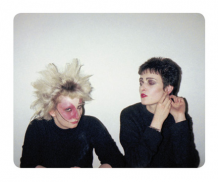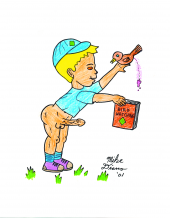| Umělec 2003/1 >> Paris is elsewhere | Просмотр всех номеров | ||||||||||||
|
|||||||||||||
Paris is elsewhereUmělec 2003/101.01.2003 Anaid Demir | q & a | en cs |
|||||||||||||
|
Cécile Paris opens her worlds to us through her seemingly simple photographs and video works.
She is called Paris after the city, but this does not mean that she confines herself to its borders. She loves movement, learning about the country, storytelling, and she enjoys giving others the chance to travel. Each picture opens up a spiritual perspective. She makes photos as she breathes. In the train standing at the station platform or on the highway, in the kitchen or in the park — with every shot she “writes notes,” which she adds to her huge photo collection. One day one picture connects to another and this creates a series, multiplying the travel possibilities to create stories. Everyone can find something here from their own world: pots or fifteen-ton trucks, a Porsche or plaster cactus, puddles or house facades, salon cats or weeds — nothing escapes her insatiable view of the shapes of colors. She tracks down people and creates for them escape routes. If we view their images from close-up we begin to doubt what they have in common. Her seemingly obvious shots are perfectly arranged. Every part leads to the next, perspectives multiply, the mind wanders. Familiarity leads to dreaminess, telling and pretense. We escape through a simple reflection in a pool of water or graffiti on glass. Cécile Paris opens little windows to parallel worlds, leaves the field to thought associations. The mental detours that she offers to us in her photos we find in movement in her video works. With the help of simple actions, people, we continue to move, move, move … What triggers your trigger? There are many things that talk about what worries me or what am I dealing with. Things repeat themselves: often there are the stories of weeds, plants, house flowers, the stories of bathrooms, kitchens, accessories, a facade, architecture, details on the ground, found objects — these all are certainly things that are easy for me to see. To observe them is training. In the end I am interested in many details that gain storytelling or sociological meaning. Something that exceeds the ordinary. It is true that everyone knows certain shapes, images, objects or colors. I take ownership of them in the pictures, I play with them, give them a bit more power. How do you connect things in the series? There are several procedures for it. I have several photos that are like my notes. I often look at them, play with them as if it was a game. The first criteria concerns formal elements: colors and so on, or complementary aspects that create a harmony among themselves. After this first phase it is like with meetings. The formal side is followed by sense, the world that steps out of the photo, and I think how it could be in harmony with another one. What kind of clashes or what beginnings of stories emerge in here. And also the title may evoke something. In your photos, all animals (dogs, cats, horses) are tame. They reveal something that is hidden under the ordinariness. Is this an expression of kitsch for you? More than anything kitsch was a movement, it is forgotten nowadays. It was a negation of townsfolk taste, taking an esthetic position. Until now the objects or decorations that could be called kitsch are the leftovers of this movement. What attracts me is that these are objects that we meet almost daily. For example, I recently raised my head and saw on one balcony a blanket with a huge tiger. Around such an object I can think of plenty of other pictures. That is how a story starts for me. It seems to me that these motifs have in them some kind of inner strength. Kitsch objects have a big testifying value for me. Thanks to the photos I can better absorb things around me. I need this photographic distance. It is as if I was distancing myself from the world in order to project myself back into it but in a different way and stronger. How can the collector take samples of the world, keep them at a certain distance and own them in a better way? There is the idea of collection, but it is not about ownership. It is rather about organizing things and understanding them in the chaos that is called the world. I allow myself to approach things that would not happen otherwise. I try to organize them among themselves. In your pictures the contrast between freedom and oppression is very present. We live at the time when almost anything that we see and what is happening is closely related to the terms freedom and oppression. It is moving around this relation today more than ever before. There is no better example than TV. I think that we unavoidably live in oppression. The freedom allows a change of view. It is the freedom of the mind. Your collections open many windows, through reflections, images, mirrors, through constant immersion into the depths. Is this a form of exoticism or an escape? The presence of exotic forms is certainly connected with the objects that were recently mentioned as kitsch. I’m truly interested in how we live and what people dream about. I cannot stop from being touched when I see how a truck driver pins up a half-naked girl with a sunset background, and it helps me every morning again to drive his truck. I try to understand how much this picture is a dream for him and why this one more than any other. There is a sociological approach in your photos, but no people appear there. Do you think that they are present? Yes, I think that it talks about them in a better way. It is like the idea of visiting someone’s house when he is not there — that will tell you a lot about people. Why are your video works in contrast to your photos, which concern just one and the same person? I make my video works in the same way as the photos. Someone is really there, but the person becomes what I call a “character” in the painting sense of this word. And this character makes a simple gesture, or rather an action: strolls, plays guitar or wanders around with a watering can. The main feature of the video is not this physical presence, this person. When I say that it is a character, it means that what is around him or her has the same importance. For example, in the video where my character waters, I came up with a plan and I thought of the weed, then the puddle where there is a reflection. So yes, we look around as the person walks forward, waters, but this is only a link. For me the person is important and what he or she is doing as well as what surrounds her. It is about their mutual interaction. All those simple and mechanical gestures of your “characters” — skateboarding as well as wiping glass — isn’t this a way of emptying the head, a way to escape, to disappear? Yes, it is about escapes. I am interested in video because of what is happening when you walk up the street or when you sit in a train, simply in the moment of the movement. It seems to me that these moments are appropriate. And what is happening in the head is often connected with what you see. And that for me is the beginning of the film, fiction. That is why in my pictures, there is always a movement. And the boy on the skateboard, taken from behind, raises multiple stories in me. Taking it all because something very mental is happening. Boy on a skateboard, but also trains, sport cars, trucks and horses — the whole world is in the movement, on and on. The synthesis of history should be the escape, rush, and introspection. Anyway, I have always loved the expression sortir a l’anglaise (take French leave)!
01.01.2003
Рекомендуемые статьи
|
|||||||||||||
|
04.02.2020 10:17
Letošní 50. ročník Art Basel přilákal celkem 93 000 návštěvníků a sběratelů z 80 zemí světa. 290 prémiových galerií představilo umělecká díla od počátku 20. století až po současnost. Hlavní sektor přehlídky, tradičně v prvním patře výstavního prostoru, představil 232 předních galerií z celého světa nabízející umění nejvyšší kvality. Veletrh ukázal vzestupný trend prodeje prostřednictvím galerií jak soukromým sbírkám, tak i institucím. Kromě hlavního veletrhu stály za návštěvu i ty přidružené: Volta, Liste a Photo Basel, k tomu doprovodné programy a výstavy v místních institucích, které kvalitou daleko přesahují hranice města tj. Kunsthalle Basel, Kunstmuseum, Tinguely muzeum nebo Fondation Beyeler.
|


































 New book by I.M.Jirous in English at our online bookshop.
New book by I.M.Jirous in English at our online bookshop.
Комментарии
Статья не была прокомментированаДобавить новый комментарий